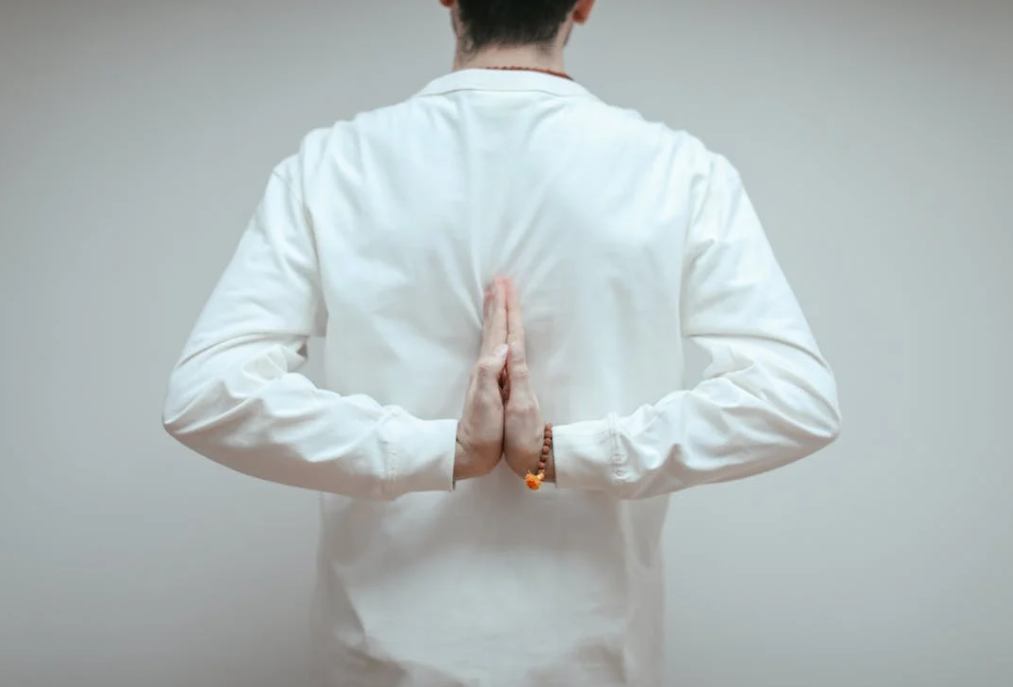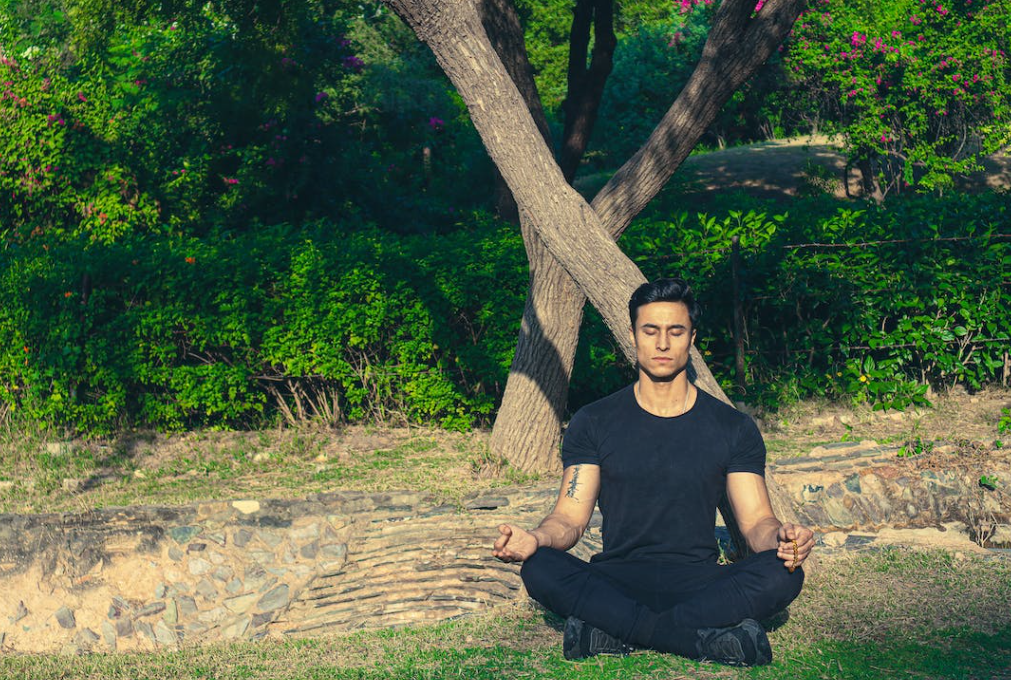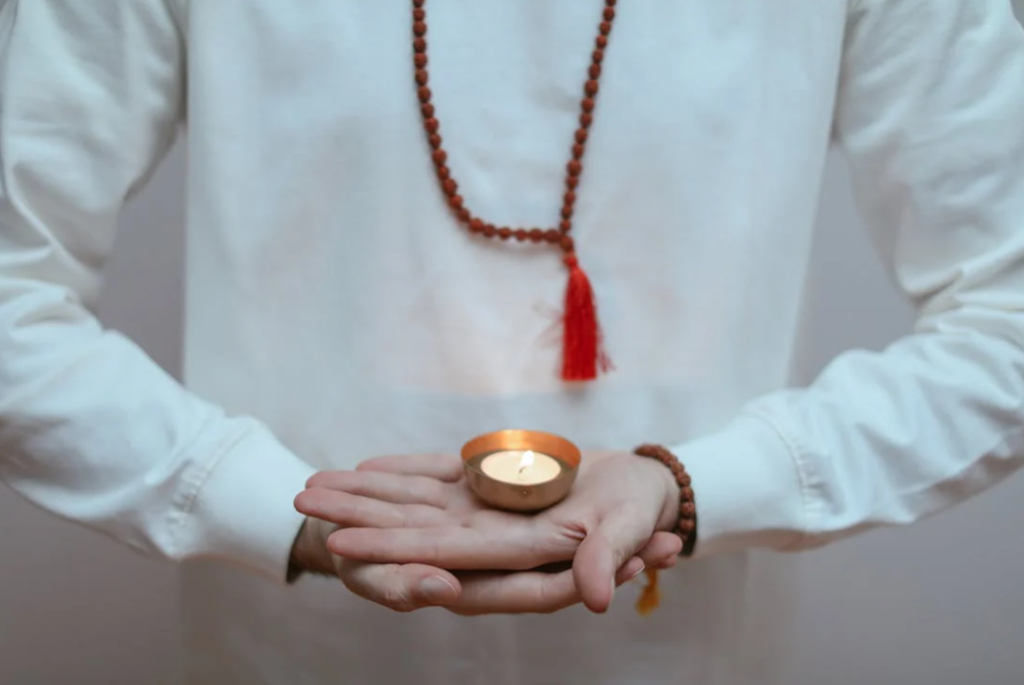Mantra Yoga
Learn about some self-practices, mala, or working with a guru, and what this article teaches us.

Selfpause Affirmation App
Download the app to get 1,000’s of affirmation meditations and everything you need to write, record and listen to your own.
If you are interested in practicing mantra yoga, there are many different ways to do so. You can practice on your own, with a mala, or with a guru. In this article, we will give you a general overview of mantra yoga. Here, you will learn how to practice mantras and how to chant them.
Chanting mantras

In mantra yoga, chanting a mantra helps us to focus on a specific intention or goal. We can do this anywhere – during a shower, in the car, while we move through an asana – as long as we make sure we’re doing it with intention and with full faith in the practice. The mantras we chant should be meaningful to us, and we should practice them on a regular basis. Some mantras are more meditative than others, and we can even make up our own.
Mantras are said to be the most powerful techniques for affecting our minds, and chanting them can influence our behavior and our thoughts. The sounds of mantras can affect the entire body and mind, allowing us to shift our subconscious patterns and become more enlightened. Here are 13 mantras for yogis that can help you connect with your inner guru and practice mantra yoga.
Mantras are sacred sounds that have an uplifting effect on our lives. They can help heal emotional imbalances and traumas, as well as spiritual blockages. They can even be used to heal relationships and other challenges in life. The ancients believed that these sounds acted on the soul’s vibration and shifted it to a higher frequency.
Chanting mantras in mantra yoga has many benefits, and it’s an ideal way to connect with the divine. It can also help you to clear blocked energy and gain a new perspective.
Practice with a mala

Whether you are meditating on a single word or the entire Gayatri Mantra, a mala will help you keep track of your mantra meditation. The repetitive recitation of a mantra is both calming and transformative. Tracing each bead with your fingers will help you stay on track as you repeat the mantra.
Whether you prefer a wooden mala or a beautiful gemstone one, the mala will make your practice more meaningful. Choose a mala made from natural materials that will relax and calm you. Choose beads that speak to you, not just ones that look pretty. When choosing your mala, you should also consider the number of beads you want to use.
A mala contains 108 beads. Traditionally, the guru bead is the 109th bead. It is larger than the other beads and represents awareness and respect. It also symbolizes the guru. By wearing a mala, you can focus on the mantra.
Before beginning your mantra yoga practice, you will need to have a sankalpa or intention. A sankalpa is a brief declaration of what you want to achieve. It will guide you when choosing a mantra and a mala. Each mala has its own energetic properties.
A mala is also an excellent meditation tool. Holding it in one hand allows you to drape it across your fingers. Some people place the guru bead around their index finger, while others use their thumb and middle fingers. Regardless of the method you choose, you should remember to keep practicing for at least 40 days.
A mala has 108 beads and is traditionally used by yogis. Most malas contain a guru bead, which is larger than the rest of the beads. Some malas also have spacer beads in between the beads.
Practice on your own

It can be difficult to find a teacher who specializes in mantra, but there are many people who offer classes, workshops, and retreats. You can find one in your area through word-of-mouth, or sign up for an online course. If you’re not comfortable with a teacher, you can try practicing on your own. The key is to focus on your breath and the sound vibrations of the mantra.
You can try chanting one mantra at a time. Choosing a mantra to chant is an individual decision, but it is often helpful to stabilize your emotions. You can either chant your mantra aloud or in silence. In addition, you can try sitting quietly and letting your mantra come to you. This is a more subtle practice and requires patience.
Mantra yoga has 16 limbs: Shudhi, Bhakti, Achara, Dharna, Mudra, Tarpana, and Yaga. Shudi and Shudhi refer to purification and internal cleansing. A teacher can help you practice these limbs by guiding you in the correct sequence.
Using mantras during yoga is a great way to focus on the vibration and meaning of sacred sounds. The practice allows you to tap into the power of psychic energy and evoke a spiritual state. Mantras can help you achieve your goals and protect you from bad karma. If done regularly, you can achieve a greater sense of well-being and connection to the supreme soul.
When practicing mantra yoga, you should first take cleansing breaths. Make sure to breathe through your nose and focus on the mantra. You should also be mindful of your thoughts and refrain from negative emotions.
Practicing with a yantra

Practicing mantra yoga with a Yantra can be an effective way to increase your spiritual awareness. A yantra contains six triangles in its center. Each triangle represents a particular aspect of the divine. The triangles that face upward represent the positive and negative sides of the universe. This helps you remember which triangles belong to which aspect of the universe.
A yantra is a geometric diagram that represents the energy field of a certain deity. It serves as a visual prop while you are meditating, and comes in many different styles. Yoga teacher Melissa Forbes, who holds yantra workshops throughout the world, recommends placing a yantra on an altar, in your office, or in your car. It can help you attract energy and enhance your meditation practice.
In addition to strengthening the aura, yantra practice helps develop one-pointed focus and deep concentration. It is recommended to practice with a yantra for 21 days in a row. This helps you develop your meditative abilities and reach a higher state of consciousness.
While practicing mantra yoga, it is important to understand the difference between mantras and yantras. While both have similar uses, they differ. One mantra has the ability to reach the subconscious mind. It can help us release blocked energy and create a positive state of mind. However, it is important to remember that mantras are not objective but are subject to the subjectivity of the individual.
To make mantra yoga more effective, you need to keep your attention focused on each repetition. A yantra serves as a reminder for your mind to focus on the mantra. If you practice in this manner, you’ll find yourself focusing on the mantra and avoiding distractions.
Our Top FAQ's
Mantra Yoga is a type of Yoga that involves the use of sound, specifically the repetition of a mantra, as a tool for spiritual growth and self-realization. It is often practiced in conjunction with other forms of Yoga, such as Hatha Yoga or Kundalini Yoga. The repetition of the mantra helps to focus the mind, calming the mental chatter and allowing the practitioner to go deeper into meditation and inner awareness.
Mantra Yoga has its roots in the ancient Indian tradition of Vedic chanting and has been practiced for thousands of years. It is believed to have originated in the Vedas, the oldest Hindu scriptures, which contain many mantras for various purposes such as healing, prosperity, and spiritual development. The use of mantras for spiritual growth and meditation was further developed in the Upanishads, a collection of philosophical texts, and the Bhagavad Gita, a Hindu scripture.
The practice of Mantra Yoga is believed to have a number of benefits, both physical and mental. It can help to reduce stress and anxiety, improve concentration and focus, and increase feelings of peace and well-being. Some people also report experiencing physical benefits such as improved sleep, reduced blood pressure, and increased energy levels.
Mantra Yoga is typically practiced by sitting comfortably in a quiet place, closing the eyes, and repeating the chosen mantra either out loud or silently to oneself. It can be done for a set amount of time, such as 10-20 minutes, or for an open-ended period. It is important to find a mantra that resonates with the individual practitioner and to practice consistently to experience the full benefits of the practice.
It is generally safe to practice Mantra Yoga, but as with any form of Yoga, it is important to listen to your body and not push yourself beyond your limits. It is also important to be mindful of the energy and intention behind the chosen mantra, as some mantras may be more powerful and potentially have a stronger effect on the mind and body. If you have any health concerns or are taking any medications, it is always a good idea to consult with a healthcare professional before starting any new exercise or meditation practice.
